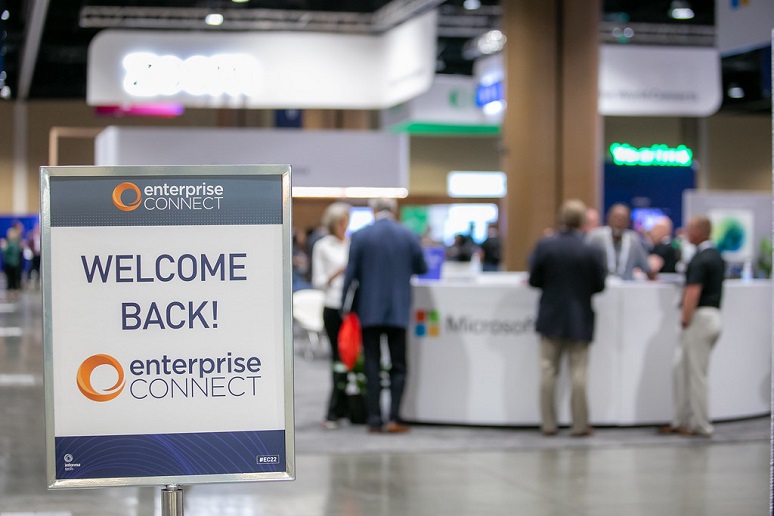Out of all the challenges facing workplace leaders, designing workplaces for the future of work remains one of the biggest (if not the biggest) challenges facing organizations today — a challenge that’ll impact the technology workplaces deploy, how and where employees work, and workplace culture itself. And last week at
Enterprise Connect 2022, March 21-24, IT and workplace leaders gathered looking for insight to make the future of work a reality within their organization.
While the event largely focused on how IT professionals are addressing the communications and collaboration needs of their organizations, many workplace trends that transcend technology were on full display during the four-day event.
Below I’ve highlighted three key event takeaways and what they tell us about where we might be going as we head toward the future of work.
1. Workplaces will take a pause, then strategize for the future
While communications and collaboration vendors shared the latest products, services, and features on how they fit into the hybrid office, many attendees (and speakers) expressed a sense that hybrid work is both a current reality and a workplace challenge with no easy, straightforward solution.
"We are really in the middle of a lot of businesses trying to figure out what hybrid work looks like, and frankly, nobody knows," Zeus Kerravala, founder and principal analyst with ZK Research, said during the locknote presentation. He added that the next six months could be "a disaster for companies" if hybrid work planning goes awry.
When the pandemic started, workplaces just did what they could to ensure that employees could work productively from home, creating a “glut of tools,” which is creating internal issues for many organizations (like
interoperability), Kerravala said. But now, as workplaces pivot to hybrid work, Kerravala sees many organizations taking a moment to pause to reflect on where they are heading and questioning their technology decisions.
“We might even see a bit of a lull in [IT] spend here, as companies actually take a step back, figure out what [hybrid work] looks like, what the rules of engagement are, how long they want people in the office, what the future of work like, and then they'll try take a more platform approach and decide what their go-forward tools would be,” Kerravala said.
2. Addressing the Great Resignation and D&I in the same breath
In one of the few Enterprise Connect sessions that didn’t solely relate to IT, Chelly Conley, director of global Diversity, Inclusion, and Belonging for
KnowBe4, shared her thoughts on improving diversity and inclusion (DNI) in the workplace even with the Great Resignation. During her presentation, Conley highlighted two crucial HR aspects to keep in mind when trying to recruit diverse talent: job descriptions and benefits.
"When you're trying to hire people ... from diverse backgrounds, they will know when you're signaling something fake, and they won't apply," Conley said. To address this, Conley suggested examining job descriptions and possibly rewriting them to appeal to candidates from diverse background. She also recommends looking at the bulleted list and education requirements and asking yourself if "every last one of these requirements is necessary."
HR professionals and recruiters also should do a full analysis of the recruiting process to find where "people from diverse backgrounds are falling off" and to ensure your workplace is even attracting candidates from diverse backgrounds in the first place, Conley said. Similarly, HR professionals and those in charge of hiring should reexamine the benefits and perks that they offer employees, Conley said. For instance, offering
flexible work schedules, daycare services, and tuition reimbursements can be crucial to finding and hiring female candidates, Conley said.
The case for DNI also couldn’t be higher. With millennials comprising 75% of the workforce by 2025 (per
Deloitte research), workplaces that “are not walking the walk, talking the talk with DNI” will see millennials leaving, as younger workers “don’t subscribe to pain and suffering,” Conley said. With the Great Resignation still raging on, investing in DNI can be a way of future-proofing your company when it comes to talent and recruiting, Conley explained.
3. VR and AR are here ... but is the metaverse?
On the last day of the event, the metaverse and the technologies that enable it — namely virtual reality (VR) and augmented reality (AR) — was a topic of hot debate among a panel of industry analysts and consultants. Some took the position that the
metaverse is pure hype, while others saw the potential for reinventing how we work.
In support of the metaverse, onConvergence analyst Tom Brannen argued that the current video meeting services “can only go so far,” and that there is a ceiling for how immersive it can get.
With the metaverse, “we can replicate the experience of people gathering in a single space, maybe seeing a presentation, and then be able to mingle," Brannen said. "On a Zoom call, only one person can talk at a time... In the metaverse, you are walking around, and with spatial audio, you can have a private conversation, while hundreds of people around you are mingling."
Countering that point, Dave Michels, an analyst for TalkingPointz, took issue with technology simply recreating real life. “New technology starts to emulate how we do things today, and then we finally figure out that we're doing right," Michels said. Sharing the example of the first softphones, Michels pointed out how the first softphones stuck too close to recreating the traditional phone-calling experience, ignoring what design made the most sense for a computer, thus creating an awkward experience.
Michels doesn’t doubt the metaverse happening, but he does question the contention that it’s happening right now. "I have no doubt that what people are loosely describing as the metaverse is coming. I have no doubt about that," he said. "It's coming, it's going to be significant, it's going to be huge, it going to be decades, and it'll be great."
Regardless of if we will see the metaverse in two years, thirty years, or ever, Kevin Kieller, co-founder of EnableUC, pointed out a bigger issue with VR and AR technology — that being the business case for deploying it. "How is the metaverse going to help you either drive revenue or reduce costs," Kieller asked. Not only that, but Kieller noted that employees currently have calendars full of meetings, and this would be one more ask from employees who are already burnout.
Despite disagreements on aspects of the metaverse, the panelists seemed in agreement when it came to VR and AR technology at least having a place at the table when it come to the future of work. "The impact [of the metaverse] might be very deep but not very broad," Robert Harris, president of Communications Advantage. "I don't think it's going to flip everything around and completely change the way we work, but I think with some elegant solutions that they'll have a very deep impact to enterprise IT."
While these trends and topics touch on a host of issues related to the workplace, one thing seems clear: In 2022, the workplace will continue to evolve, bringing with it a host of changes to the technology, culture, and the mode in which employees work.
To learn more about the Enterprise Connect event and catch up on other event coverage and news, make sure to visit the “
Enterprise Connect 2022” page on our sister site No Jitter.






